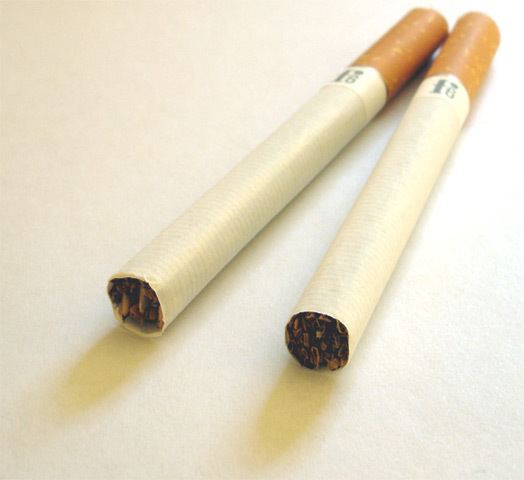 | ||
Golden Bat is one of the cigarette brands, which is produced by JT (Japan Tobacco Inc.), and is a filterless cigarette. Tar : 18 mg / Nicotine : 1.1 mg
Contents
History
The brand has been popular with the alias "Bat" for a long time. After enforcement of the tobacco monopoly system in Japan, in September 1906 (Meiji 39), it was placed on the market by the then Monopoly Bureau, The Ministry of Finance (the forerunner of Japan Tobacco and Salt Public Corporation). In the present cigarette market, Golden Bat is famous for being the oldest brand in Japan as it reached a centennial in 2006.
It used to feature a slender roll, and was manufactured for the general public. Although it has not had explosive popularity since the first, there are habitually ardent and deep-rooted smokers of it. That can be the reason leading to an exceptional long seller.
As of July 2006, it is 140 yen per a 20-pack and known as the cheapest cigarette in Japan. It is taxed low due to using the low grade of tobacco leaves categorized into the third class. Incidentally it was 4 sen (0.04 yen) per a 10-pack when it was put on the market in 1906.
In background of using a bat as the brand, at first export to China, in which a bat symbolized the good luck, was being planned. As a product for export, it had been manufactured since 1905 (Meiji 38), a year earlier than domestic sale.
The old-fashioned package that shows Golden Bats on a moss-green background is known extensively, and it is coming to be reevaluated as a nostalgic design these days. Although the detail of the design was changed several times due to extremely long history, by and large the original design has been maintained.
Appearance of the package was changed widely in 2005, for new warning phrase put on it. Habitual smokers of Golden Bat criticized it as destroying history, however the design has changed afterwards, with silver paper and a tag. Also the roll size of cigarette was changed into the same size as the general ones, and both of the roll and flavor became thicker than before.
Controversy
As part of the plans for the exploitation of China, during the thirties and forties the subsidiary tobacco industry of Mitsui had started production of special "Golden Bat" cigarettes using the then popular in the Far East trademark. Their circulation was prohibited in Japan and was used only for export. Local Japanese secret service under the controversial General Kenji Doihara had the control of their distribution in China and Manchuria where the production exported. In their mouthpiece there were hidden small doses of opium or heroin and by this millions of unsuspecting consumers were addicted into these narcotics, while creating huge profits. The mastermind of the plan, the General of the Imperial Japanese Army Kenji Doihara later prosecuted and convicted for war crimes before the International Military Tribunal for the Far East, sentenced to death, but no actions ever took place against the company which profited from their production. According to testimony presented at the Tokyo War Crimes trials in 1948, the revenue from the narcotization policy in China, including Manchukuo, was estimated in twenty to thirty million yen per year, while another authority stated that the annual revenue was estimated by the Japanese military at 300 million dollars a year.
Anecdote
In habitual smokers of Golden Bat, there were some famous writers, and the name of "Bat" appears in their literary works. Well known story, writers Ryūnosuke Akutagawa, Osamu Dazai and Chūya Nakahara loved to smoke Golden Bat. Hyakken Uchida liked high-quality cigarettes, such as "Asahi", "Peace", but he mentioned "Bat" as the cigarette he desired to smoke sometimes. The naturalist, Minakata Kumagusu also smoked Golden Bat, and he used its box as a specimen case of a slime germ he collected.
From the prewar 1940 (Showa 15) until the postwar 1949 (Showa 24), the name of Golden Bat was considered as a hostile word and changed into "Kinshi" meaning a golden kite. That was based on the mythology of Emperor Jimmu, who was the first emperor of Japan. The design was also changed along with it. At first a golden kite perching on the edge of a bow was designed, however, it was changed to without a bow due to indication that it can be irreverent if the package drawn a golden kite perching on the edge of a bow was thrown away and stepped on. In the mythology of Emperor Jimmu, a golden kite perching on the edge of a bow led to a victory.
Popular Belief of Tobacco Dust
Owing to such a cheap price and the uneven taste (considerably changeable by the difference of the manufacturing period and humidity), there is a rumor that Golden Bat is made of tobacco dust spilled out of other tobaccos in manufacturing; however this popular belief is different from truth.
In fact, as main material, the veins of leaves which has a low grade of taxation and not used for the high-class tobaccos are used for Golden Bat, therefore the cause of the uneven taste is due to difficulty of regulating uniform flavor. People who love extremely Golden Bat enjoy even this "uneven taste".
Derivatives
Golden Bat with filters in the box type was placed on the market nationwide in 1997. The package was redesigned modernly, and TV commercial and advertisement were spread out widely. The price, quantity of tar and nicotine were almost the same as general ones, and it was a kind of a new brand which remains of the oldest tobacco brand of Japan; however, it was discontinued in May 2003. After that in July 2004, although Golden Bat Box (tea flavor) and Golden Bat Menthol Box (cassis flavor) were put on the market in Miyagi Prefecture, these tobaccos also did not lead to stability of purchasing and discontinued in February 2005.
